Text
Progress on my JFJ sweater using @knit-the-terror‘s pattern.
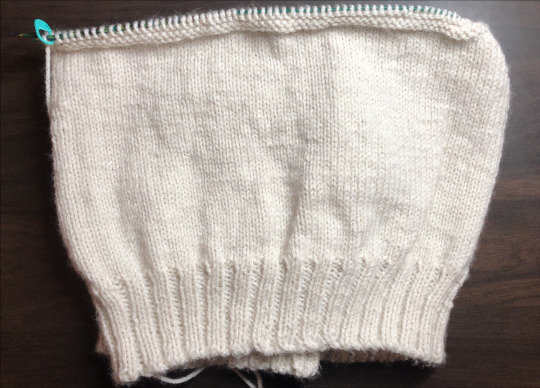
I’m just past the “ridge” chart, which separates the plain stockinette bottom from the textured top. I’m knitting a size small in a worsted weigh yarn (a larger gauge than the original) to fit my preferences and to save my wrists.
28 notes
·
View notes
Photo
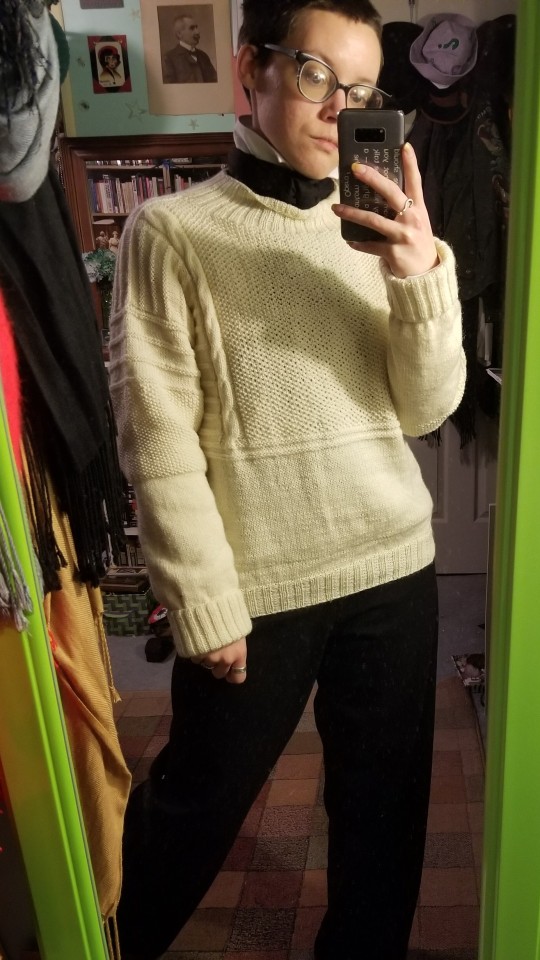
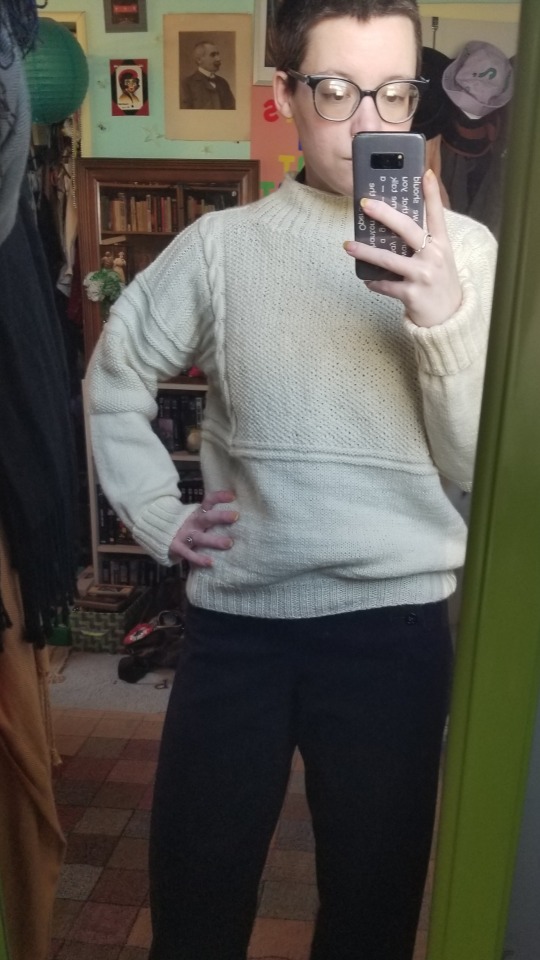


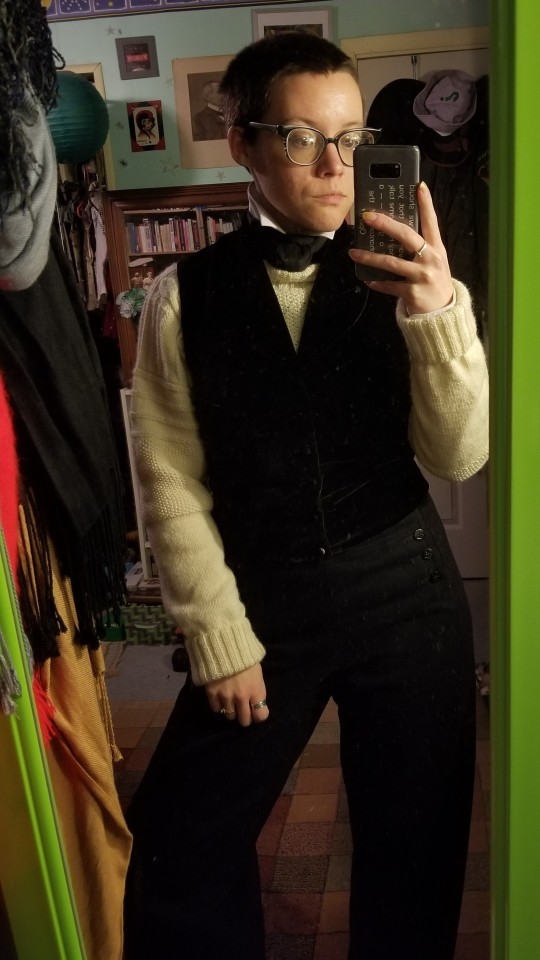
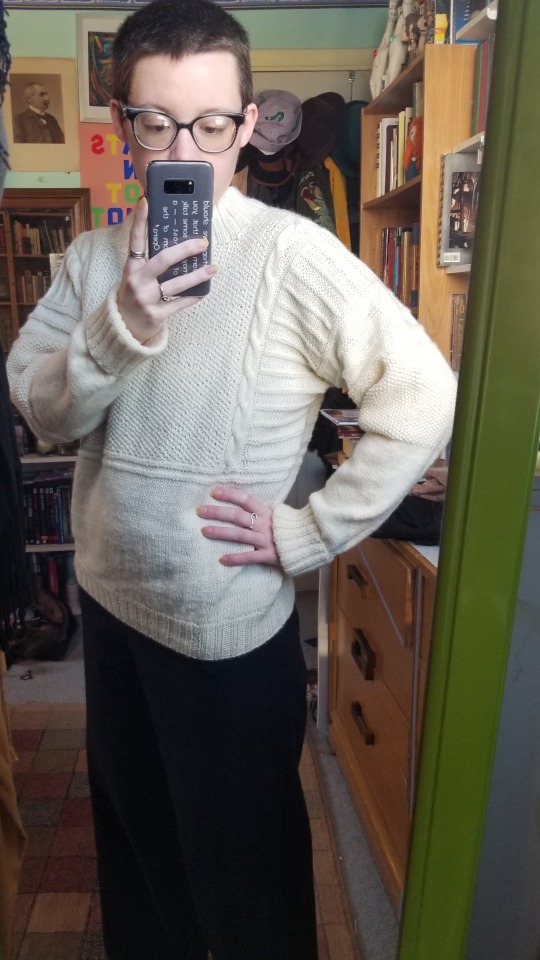
And that is A Wrap on the Fitzgender sweater!
I ended up working my own pattern design but @knit-the-terror‘s posts were super helpful when I was starting as was this website.
Refs/pattern notes under the cut
Keep reading
111 notes
·
View notes
Text
Throwing in some process photos since folks seem interested :)
The beads all had to be strung on the thread ahead of time - I did this in sections which as you can imagine resulted in a lot of stray ends to sew in.



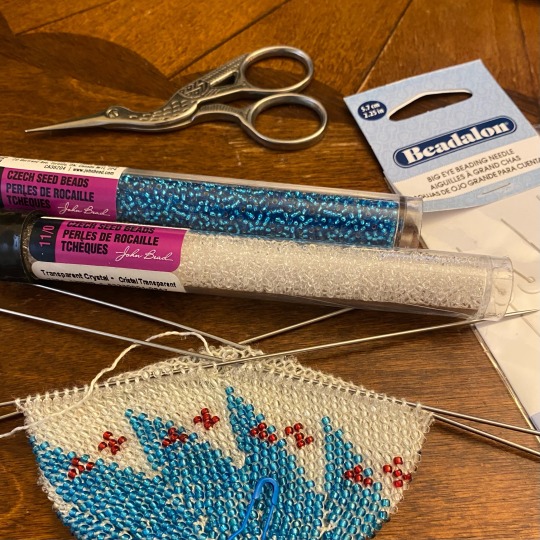

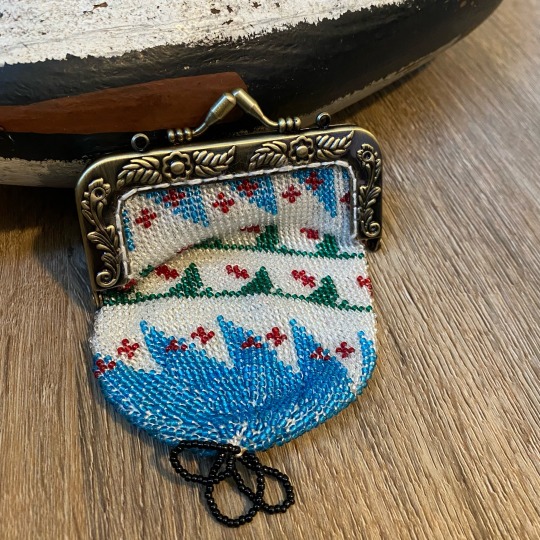
I have completed my reproduction of the Franklin bead purse!
Unfortunately we don’t know who the owner of this object was, but given the complexity I’d like to think it was made specifically for its owner rather than picked up as a souvenir (although that is also possible).
I used size 11 seed beads and size 0000 (US) knitting needles. It still came out larger than the original, so I may try again with smaller beads.
The final image is the original purse, held at Royal Museums Greenwich
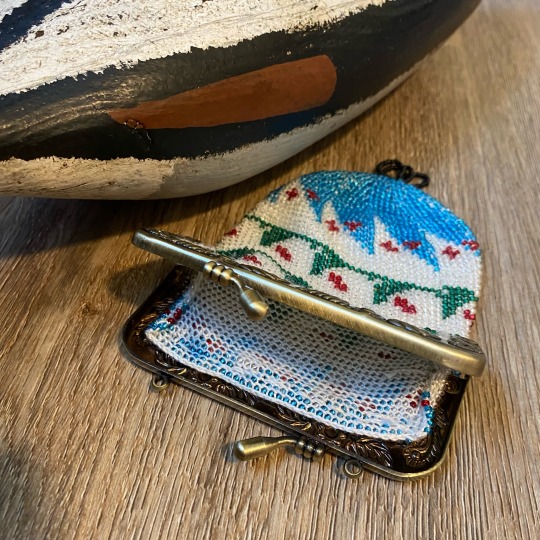
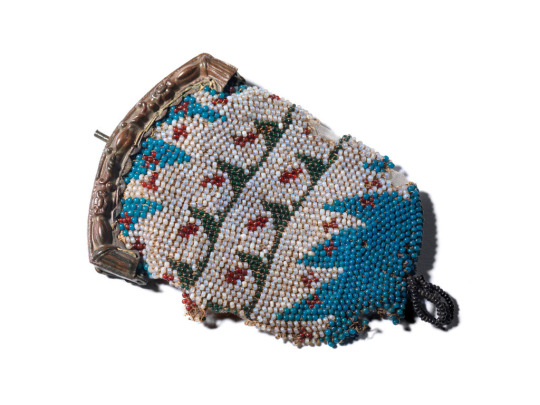
393 notes
·
View notes
Note
i am incredibly excited to discover this blog because i’ve never seen anyone discuss guernsey jumpers online before! and in the context of The Terror too! let me know if you want to see the collection my Gran made for me…
As usual checking my messages a month late but yes, I always want to see all the knitwear!! To any of my followers, if you see historic knits in the wild, yes I want to be tagged. Just maybe better on Twitter where I might remember to log on once in a while.. 😅
7 notes
·
View notes
Text

I have completed my reproduction of the Franklin bead purse!
Unfortunately we don’t know who the owner of this object was, but given the complexity I’d like to think it was made specifically for its owner rather than picked up as a souvenir (although that is also possible).
I used size 11 seed beads and size 0000 (US) knitting needles. It still came out larger than the original, so I may try again with smaller beads.
The final image is the original purse, held at Royal Museums Greenwich


393 notes
·
View notes
Text
@so-i-did-this-thing mentioned that folks at Terror Camp loved this Franklin relic that was recreated for the show but never made it on screen. It's knit with glass seed beads, so you know I had to work on putting together a pattern chart! I will put together a more professional version shortly, but here's the quick mockup I did in Excel.
To make a purse like this, the beads would have to be strung onto the silk thread before knitting, which means very careful counting. I love that in the original you can see places where the knitter didn't quite count correctly and the pattern is a little off, but they kept going and ended up with an awesome result anyway.
The original purse is held at Royal Museums Greenwich.


128 notes
·
View notes
Text
This is my new favorite sweater model!! 🐧
@hangingfire, you did a great job on this tiny sweater! I particularly like the addition of initials.

I knitted a JFJ sweater!
Okay, it's not much bigger than my hand. It's a test run, using the sampler gansey pattern in Beth Brown-Reinsel's Knitting Ganseys, and @knit-the-terror's charts. I followed the overall sampler pattern and substituted in the JFJ stitch patterns where appropriate—and in following Brown-Reinsel's instructions to knit initials onto the front side, of course I knitted in a JF.
I've never successfully knitted a sweater before, so I figured before I got stuck in for real on this project, i should get in some practice. Also, I needed to see if Brown Sheep Cotton Fleece would be an acceptable yarn, because I can't do 100% wool (sensitivity issues and also I live in Texas and it's rarely cold enough here for that). (And the answer is yes; thanks, Gauge Yarn in Austin TX for the recommendation.)
I'm less than thrilled with the sleeves (should have done more work on the smaller DPNs) and the underarm gussets came out funny-looking because I was trying to be clever with the pattern, and I should really know better by now. Still, as a proof of concept and a practice run on sweater-knitting skills, it was extremely valuable.
So once I finish the raglan sweater I'm working on now? We're off.
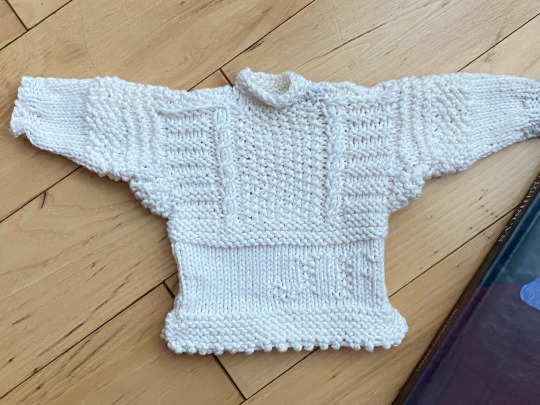



457 notes
·
View notes
Text

I knitted a JFJ sweater!
Okay, it's not much bigger than my hand. It's a test run, using the sampler gansey pattern in Beth Brown-Reinsel's Knitting Ganseys, and @knit-the-terror's charts. I followed the overall sampler pattern and substituted in the JFJ stitch patterns where appropriate—and in following Brown-Reinsel's instructions to knit initials onto the front side, of course I knitted in a JF.
I've never successfully knitted a sweater before, so I figured before I got stuck in for real on this project, i should get in some practice. Also, I needed to see if Brown Sheep Cotton Fleece would be an acceptable yarn, because I can't do 100% wool (sensitivity issues and also I live in Texas and it's rarely cold enough here for that). (And the answer is yes; thanks, Gauge Yarn in Austin TX for the recommendation.)
I'm less than thrilled with the sleeves (should have done more work on the smaller DPNs) and the underarm gussets came out funny-looking because I was trying to be clever with the pattern, and I should really know better by now. Still, as a proof of concept and a practice run on sweater-knitting skills, it was extremely valuable.
So once I finish the raglan sweater I'm working on now? We're off.




457 notes
·
View notes
Note
I think you’re right! I hadn’t heard “lice stitch” before but it does make sense. The pattern you linked would work great for duplicating Blanky’s - just add some striping on the cuffs and collar.
First up, your blog is amazing and you're such a talented knitter! Secondly, do you happen to know if anyone's made a pattern for Blanky's jumper he wears while he's waiting for the tuunbaq? I figured if anyone might it could be you!
Thank you! Blanky’s sweater is a Nordic design that I’ve also heard called a “North Sea” pattern.
Unfortunately I have not found a knitting pattern that is exact, but this one is similar. It’s done with a raglan yoke, unlike Blanky’s, but I think it has the right vibe. I’ve also seen this stitch pattern used on knitwear from other Arctic expeditions (particularly Andrée’s balloon attempt at the pole), so it has that going for it!
34 notes
·
View notes
Note
First up, your blog is amazing and you're such a talented knitter! Secondly, do you happen to know if anyone's made a pattern for Blanky's jumper he wears while he's waiting for the tuunbaq? I figured if anyone might it could be you!
Thank you! Blanky’s sweater is a Nordic design that I’ve also heard called a “North Sea” pattern.
Unfortunately I have not found a knitting pattern that is exact, but this one is similar. It’s done with a raglan yoke, unlike Blanky’s, but I think it has the right vibe. I’ve also seen this stitch pattern used on knitwear from other Arctic expeditions (particularly Andrée’s balloon attempt at the pole), so it has that going for it!
34 notes
·
View notes
Photo
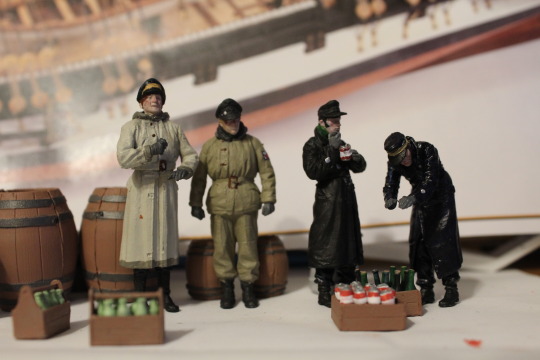



Taking my The Terror obsession too far by painting miniature cold boys.
440 notes
·
View notes
Text
44 buttonholes to sew by hand, I better make a playlist of bingewatching Contrapoints videos
105 notes
·
View notes
Text



‘Delicious veal soup with absolutely no lead! Please enjoy!’ / ‘Maybe if you have some of your lead and veal soup you’ll calm down’
Cross stitch piece for @theterrorbingo prompt ‘Goldner’s Cans’ ☠️
50 notes
·
View notes
Photo




“[…] I hope you do not think me so weak as to labour under any presentiment of evil; but remember this is no common voyage, and two years is a long period to look forward to in the life of the healthiest and the least exposed to risks. Only one half of Sir John Franklin’s former party returned with him , and our “Terror” in her last voyage with Captain Back was so crushed by the ice that she could not have been kept afloat another day, when they got into Loch Swilly. Two years is a long time without any tidings, and perhaps we may be three years at least. Do not give us up, if you hear nothing. But now I will throw over a new leaf with the rest of my letter, and tell you that I am very sanguine of succeeding in the object of our expedition.”
Lieutenant John Irving to his sister-in-law, Katie. HMS “Terror,” Woolwich, 18th April 1845.
∟ for @theterrorbingo, “letters.”
219 notes
·
View notes
Text
It occurs to me that in my absence I never posted these here.
REDESIGNED Franklin gloves, after one recovered from KWI by McClintock’s crew, for which a colleague recently tracked down an 1860 photo.
These were knit on size 1 needles using a sock weight yarn. The engraving is from the Illustrated London News, and the photo (linked above) is in the Tasmanian Archives.


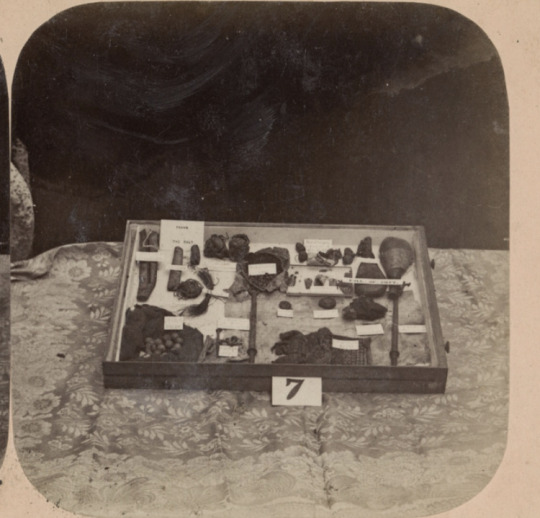
101 notes
·
View notes
Text
Found a book I need to buy, lads
Sailors Needlework
Due to the fact that sailors had to mend their own clothes and there was always a sailmaker with his mates, many on board were very talented sewers. Therefore, many of them went beyond simple mending and created their own clothes. Or began to embellish their pieces with embroidery or make presents for their loved ones. Or earning some money on the side with their skills.

Sailor doing needlework, c. 1850 by unknown in: Jack Tar a Sailors Life, by J. Welles Henderson
It is not possible to pinpoint the exact origins, as many pieces have been lost over time.

A knitted wool hat and handsewn pants, from HMS Invincible, 1758, in: The First HMS Invincible (1747-58): Her Excavations (1980-1991), by John M Bingeman
Some pieces date from the 18th century, while most seem to date from the 19th or 20th century. However, it can be assumed that there are also much older examples.
Embroideries
This type of decoration was embroidered with coloured silk or wool threads on the shirts or duffle bags. But also ribbons, bags or money belts were decorated.
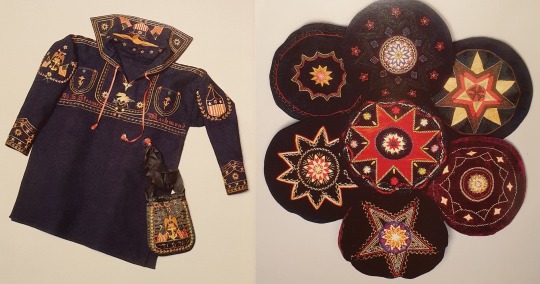
Sailor blouse and poke bag, made by George W.W. Dove, c. 1860 - Sailor’s Hats, c. 1850-1900 in: Jack Tar a Sailors Life, by J. Welles Henderson
Then names, mottos, stars, figures, ships, flags or anchors were embroidered on them.

Money belt, c. 1850 in: Jack Tar a Sailors Life, by J. Welles Henderson
Often the work was done in simple chain-stitch and the material was either taken from home or bought in a harbour.
Wollies
This type of embroidery is a very special form of embroidery, the embroidered woolen pictures, called woolies, which have been around since the 1840s. Most of the materials used to make woolies were found on board ships. Sailcloth, duck cloth from sailor’s trousers or a simple linen or cotton fabric served as the backing. The runner was usually made from surplus wood with simple mortise and tenon joints, without wedges.

Theatrical curtains, often depicting trade union banners, suggest the artist was a merchant sailor. c. 1875 - HMS Trafalgar, c. 1865 (x)
Only the Berlin wool, cotton or silk had to be brought from home or purchased in a foreign port. The sailors mainly chose vivid colours - especially white, blue, red, brown and various shades of green. Early Woolies are made from naturally dyed wool. After the development of chemical dyes in the mid-1850s, sailors could obtain a wider range of colours at a cheaper price.

HMS Cumberland, c. 1842 - A third rate together with a paddle steamer, c. 1860-1880 (x)
When making a woolie, the sailor sometimes first sketched the outline of the ship and rigging in ink. With only these schematic designs, he then sewed these images freehand directly onto the canvas, using both rudimentary and refined stitches. Indeed, many Woolies show charming liberties taken with the appearance of elements other than the ship.

Multiple ships raise the value of a piece. This one showcases a second-rate ship, fourth-rate ship, frigate, and smaller ship, 1875 - HMS Queen a present from my son, c. 1855 (x) in: Jack Tar a Sailors Life,by J. Welles Henderson
The sailors used a wide variety of stitches, such as cross stitch, chain stitch, darning and the quilting technique called trapunto. Many of these pictures were appropriately made for the dearest ones at home. As the Victorians liked to collect, the pictures quickly became very popular and were often sold.
Knitting
The men on board also did this. Even though it’s hard to imagine how old salts sat there and knitted. But for the cold days, the men needed warm clothes and so they knit socks, gloves and scarves.
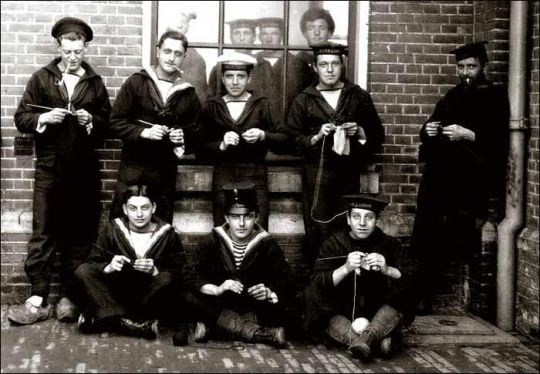
British sailors knitting or crocheting (and looking like they enjoy it!) during WWI (x)
(Those who have read the Hornblower novels by CS Forester will perhaps remember that in some books it is mentioned that the men sat there and knitted.) It is verifiable that the Sailors knitted from the 18th century onwards, but since this art had also been known since the 13th century, it must have come on board earlier.
4K notes
·
View notes
Text
Sailors Needlework
Due to the fact that sailors had to mend their own clothes and there was always a sailmaker with his mates, many on board were very talented sewers. Therefore, many of them went beyond simple mending and created their own clothes. Or began to embellish their pieces with embroidery or make presents for their loved ones. Or earning some money on the side with their skills.

Sailor doing needlework, c. 1850 by unknown in: Jack Tar a Sailors Life, by J. Welles Henderson
It is not possible to pinpoint the exact origins, as many pieces have been lost over time.

A knitted wool hat and handsewn pants, from HMS Invincible, 1758, in: The First HMS Invincible (1747-58): Her Excavations (1980-1991), by John M Bingeman
Some pieces date from the 18th century, while most seem to date from the 19th or 20th century. However, it can be assumed that there are also much older examples.
Embroideries
This type of decoration was embroidered with coloured silk or wool threads on the shirts or duffle bags. But also ribbons, bags or money belts were decorated.

Sailor blouse and poke bag, made by George W.W. Dove, c. 1860 - Sailor’s Hats, c. 1850-1900 in: Jack Tar a Sailors Life, by J. Welles Henderson
Then names, mottos, stars, figures, ships, flags or anchors were embroidered on them.

Money belt, c. 1850 in: Jack Tar a Sailors Life, by J. Welles Henderson
Often the work was done in simple chain-stitch and the material was either taken from home or bought in a harbour.
Wollies
This type of embroidery is a very special form of embroidery, the embroidered woolen pictures, called woolies, which have been around since the 1840s. Most of the materials used to make woolies were found on board ships. Sailcloth, duck cloth from sailor’s trousers or a simple linen or cotton fabric served as the backing. The runner was usually made from surplus wood with simple mortise and tenon joints, without wedges.

Theatrical curtains, often depicting trade union banners, suggest the artist was a merchant sailor. c. 1875 - HMS Trafalgar, c. 1865 (x)
Only the Berlin wool, cotton or silk had to be brought from home or purchased in a foreign port. The sailors mainly chose vivid colours - especially white, blue, red, brown and various shades of green. Early Woolies are made from naturally dyed wool. After the development of chemical dyes in the mid-1850s, sailors could obtain a wider range of colours at a cheaper price.

HMS Cumberland, c. 1842 - A third rate together with a paddle steamer, c. 1860-1880 (x)
When making a woolie, the sailor sometimes first sketched the outline of the ship and rigging in ink. With only these schematic designs, he then sewed these images freehand directly onto the canvas, using both rudimentary and refined stitches. Indeed, many Woolies show charming liberties taken with the appearance of elements other than the ship.

Multiple ships raise the value of a piece. This one showcases a second-rate ship, fourth-rate ship, frigate, and smaller ship, 1875 - HMS Queen a present from my son, c. 1855 (x) in: Jack Tar a Sailors Life,by J. Welles Henderson
The sailors used a wide variety of stitches, such as cross stitch, chain stitch, darning and the quilting technique called trapunto. Many of these pictures were appropriately made for the dearest ones at home. As the Victorians liked to collect, the pictures quickly became very popular and were often sold.
Knitting
The men on board also did this. Even though it’s hard to imagine how old salts sat there and knitted. But for the cold days, the men needed warm clothes and so they knit socks, gloves and scarves.

British sailors knitting or crocheting (and looking like they enjoy it!) during WWI (x)
(Those who have read the Hornblower novels by CS Forester will perhaps remember that in some books it is mentioned that the men sat there and knitted.) It is verifiable that the Sailors knitted from the 18th century onwards, but since this art had also been known since the 13th century, it must have come on board earlier.
4K notes
·
View notes